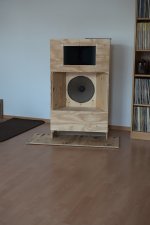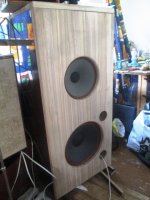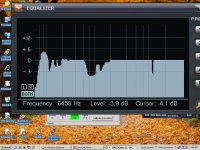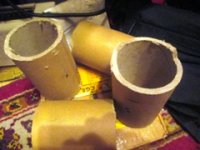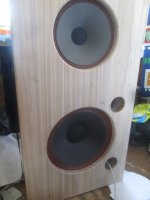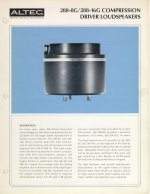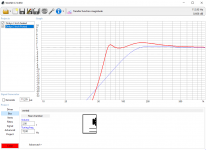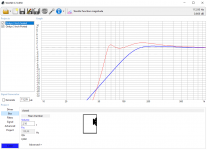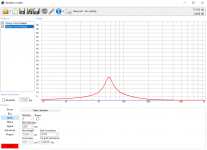DIYers rarely stop at one pair of speakers. Its hard to stop after just one cookie.
Start with a modest budget. Keep it simple and learn some stuff… it will give you a much broader base for the next one. if you want to keep it real simple, start with a single driver project.
dave
For me there are two routes for speaker design: the computer calculation method and the knowledge (experience) based method.
After choosing the way of DIY audio and having an Oscar Wilde like taste, it was clear that, in this life, I wouldn't have the chance to buy ready made speakers, so they had to be selfmade and unique.
The most important thing in cooking without a recipe book is to know the ingredients and have a good ability to truly judge about the outcome (=sound) of the speakers. If they are not able to satisfy (and they are mostly not able fully able in their first incarnation) then optimize, change or cancel and do a new build.
As I'm only into high efficiency, old speakers, I was shocked what great part the frequency dividing network could have. It makes or breaks every design.
So its absolute possible to have a good design for an enclosure but the wrong network breaks it. And thats the point where experience enters the game.
To cook a meal without a recipe from a cookbook is impossible when there is no ability to judge the result. So to know what is the sound that this speaker could be able to produce is absolute necessary to trim the speaker into the right direction.
By now, I've only dealt with full bandwith resonant speaker designs and two way speakers. And I have to admit, that my designs would not win the award for lowest octave high efficiency speaker, but thats not their design goal anyway. They should sound fast, direct, with great energy and impact. Mids are my favorite, highs should be there but never outstanding, just relaxed and never boring or ringing in the ears. Woofer should sound like a drum, thats best (for me). The whole system should sound coherent. Thats not easy to get those days because it seems out of fashion.
So my latest is a two way prototype, full horn system, 99dB/1W efficiency, all Alnico driven chassis, woofer is 16 inch full paper cone with paper surround in a front and backloaded cabinet, horn driver is 2.8" voice coil alnico aluminum with more than 100dB eff. and a nice 500 Hz horn.
Speaker network consists of old parts like autoformers, oil caps, big transformer coils etc.Simple but efficient when it comes to let those two drivers shine.
I really like the sound, altough the carpenter is waiting to put it in a more eye friendly fashion with a nicer wood surface. Btw, wood is a simple and resonant box plywood with very few plies, made from fir plywood and with minimal damping for the woofer. Straight in the tradition of Western Electric speakers or old Altecs. And thats what it sounds like, just a little more refined and coherent. Like an old wide bandwith speaker tube radio. Just a little bigger in sound and dimensions.🙂
For me, its a complete different thing to understand why speakers sound the way they sound or to simply put cash on the counter of a salesman shop and have the whole thing being installed at home ready to use. The second is an easy way, the first needs more ambition, but offers more options in the end to make it a speaker that really matches the owners needs and goals. Sometimes, when budgets or markets exclude or couldn't offer the dream speakers, DIY is the only option for reaching own goals.
Attachments
Last edited:
BasicHIFI1 yes open baffle is an area I have not explored, but certainly one that should be considered!
Very nicely put Shcmitz77! There is a lot in the thread about simulation, but that only gives you an idea, actually building and trying different things is where the rubber hits the road, and learning what seemingly subtle things do to change the sound is invaluable.
I've related before elsewhere probably not this thread, about how huge a difference a change in the crossover made for my MTM's. The change was not subtle at all. Crossover frequency was quite similar, and the on axis response was also very similar, but the crossover order and the phase matching was where they differeed, and it made a very big difference to the sound.
Experimenting is the key to learning how those ingredients interact. To anyone reading, don't be afraid to experiment! 🙂 A very good example of someone doing simulations and then building stuff to see how it really turns out. Modular active 3 way - work in progress
The simulation Don is doing with ABEC is beyond what I've learnt but is is the simulation, building, listening, measuring and correlating them all that is very inspiring about this thread.
Tony.
Very nicely put Shcmitz77! There is a lot in the thread about simulation, but that only gives you an idea, actually building and trying different things is where the rubber hits the road, and learning what seemingly subtle things do to change the sound is invaluable.
I've related before elsewhere probably not this thread, about how huge a difference a change in the crossover made for my MTM's. The change was not subtle at all. Crossover frequency was quite similar, and the on axis response was also very similar, but the crossover order and the phase matching was where they differeed, and it made a very big difference to the sound.
Experimenting is the key to learning how those ingredients interact. To anyone reading, don't be afraid to experiment! 🙂 A very good example of someone doing simulations and then building stuff to see how it really turns out. Modular active 3 way - work in progress
The simulation Don is doing with ABEC is beyond what I've learnt but is is the simulation, building, listening, measuring and correlating them all that is very inspiring about this thread.
Tony.
Hello friends. 🙂
This is a topic that is dear to me. So is "making silk purse from sow's ear" thread.
Where I live, there is very little options for reasonably-priced, decent drivers with complete T/S parameters. No Dayton Audio equivalent here! Most of the beginner DIY-ers just make a box that looks cool and tweak by ear.
Over the years, I've acquired Dayton USB measurement mic, REW, and recently I've started learning to use impedance measurement functions of REW, as well as tweaking crossover designs in XSim. I feel like I'm heading in the right directions, and I want to keep learning.
One question from me please: speaking of "designing speaker from scratch", is there a general guidelines of "voicing" your own designs? For example, boost around xx frequency will emphasize sibilance, cut around xx frequency will give the impression of ... etc.
I know we generally aim for the flattest response, but this question comes to mind when doing simulations on XSim, sometimes we have to compromise a little bit here and there, considering component values, whether it's worth it to add a notch filter or not, etc.
Also, is there a thread where we just share pictures of our build and the final project? Thank you!
This is a topic that is dear to me. So is "making silk purse from sow's ear" thread.
Where I live, there is very little options for reasonably-priced, decent drivers with complete T/S parameters. No Dayton Audio equivalent here! Most of the beginner DIY-ers just make a box that looks cool and tweak by ear.
Over the years, I've acquired Dayton USB measurement mic, REW, and recently I've started learning to use impedance measurement functions of REW, as well as tweaking crossover designs in XSim. I feel like I'm heading in the right directions, and I want to keep learning.
One question from me please: speaking of "designing speaker from scratch", is there a general guidelines of "voicing" your own designs? For example, boost around xx frequency will emphasize sibilance, cut around xx frequency will give the impression of ... etc.
I know we generally aim for the flattest response, but this question comes to mind when doing simulations on XSim, sometimes we have to compromise a little bit here and there, considering component values, whether it's worth it to add a notch filter or not, etc.
Also, is there a thread where we just share pictures of our build and the final project? Thank you!
The most important part of any design (at least for me) is to become a feeling for your parts sound first before making a theoretical plan what to do with them.
The second most important is, have a listen to speakers you really love their sound.
Once you have a feeling for what you want to achieve, you have the most trustworthy instrument deliverd by nature: your ears.
To have a feeling for what to achieve in sound is almost easy: listen to as much high quality speakers as possible.
Thats the way every expert (connaisseur) on a given field of taste (wine, food, speakers, amps, pictures, you name it) tries to achieve his expertise. Without this expertise, your almost lost because measurements are just measurements and can never describe in full what your ears hear. They can only deliver flat response or other parts (fractions) of the whole sound. But your ear can deliver more.
With that, I wouldn't say that its always possible to design speakers just by ear, often its good to have those measurements. But they are not the last word in audio. They are little helpers to reach the goals.
So if you have heard and become familiar with the speaker chassis and have a feeling of how they would sound in an enclosure, toy around with them and try some enclosures.
You will instantly become a feeling of what sound they can produce, how mods are changing their character etc.
Its possible to mod ready made speakers, too and many do. With different values of the network, with same values but different parts, with a complete different network.
Nothing is written in stone here and the designers only had taken the approach to realise their ideal of sound, which mustn't fit your's.
So best is to listen as much as possible and trying things in the real world.
If the goal could be only achieved because the speakers become too complex, with measurements, then do measurements.
I have to say that I did my designs not with measurements because they never have to pass any testing for them. No other person have to say "thats a good speaker" and I'm not selling them either. But when I build and frickled around with them, it was most often instantly clear when they sounded "right". Then change it in the same direction further and you will notice, that they become more sounding "false". When they sound right, they will sound very detailled, like a monitor speaker. The enclosure just put spice to them but otherwise nearly dissappears. Thats the moment when they sound correct to me.
No frequency being overpronounced, flat response, very detailled and with a fast bass response which is always restricted in response, never bloomy like so many speakers.You can say, when the enclosure and the whole speaker does contribute a minimum of own sound, then its most often the right mix and the tune in is finished.
And always try to keep things (networks, cabinets) easy and not complex. Complex networks eat and store energy, complex cabinets sound complex and both are not what you want. If the drivers are in need of complex networks to become workable with, most often they are of low quality or the whole design idea is ill fated from the beginning. You want a LOUDspeaker and not a monster that eats energy from your amps and delivers nothing in response other than heat.
The second most important is, have a listen to speakers you really love their sound.
Once you have a feeling for what you want to achieve, you have the most trustworthy instrument deliverd by nature: your ears.
To have a feeling for what to achieve in sound is almost easy: listen to as much high quality speakers as possible.
Thats the way every expert (connaisseur) on a given field of taste (wine, food, speakers, amps, pictures, you name it) tries to achieve his expertise. Without this expertise, your almost lost because measurements are just measurements and can never describe in full what your ears hear. They can only deliver flat response or other parts (fractions) of the whole sound. But your ear can deliver more.
With that, I wouldn't say that its always possible to design speakers just by ear, often its good to have those measurements. But they are not the last word in audio. They are little helpers to reach the goals.
So if you have heard and become familiar with the speaker chassis and have a feeling of how they would sound in an enclosure, toy around with them and try some enclosures.
You will instantly become a feeling of what sound they can produce, how mods are changing their character etc.
Its possible to mod ready made speakers, too and many do. With different values of the network, with same values but different parts, with a complete different network.
Nothing is written in stone here and the designers only had taken the approach to realise their ideal of sound, which mustn't fit your's.
So best is to listen as much as possible and trying things in the real world.
If the goal could be only achieved because the speakers become too complex, with measurements, then do measurements.
I have to say that I did my designs not with measurements because they never have to pass any testing for them. No other person have to say "thats a good speaker" and I'm not selling them either. But when I build and frickled around with them, it was most often instantly clear when they sounded "right". Then change it in the same direction further and you will notice, that they become more sounding "false". When they sound right, they will sound very detailled, like a monitor speaker. The enclosure just put spice to them but otherwise nearly dissappears. Thats the moment when they sound correct to me.
No frequency being overpronounced, flat response, very detailled and with a fast bass response which is always restricted in response, never bloomy like so many speakers.You can say, when the enclosure and the whole speaker does contribute a minimum of own sound, then its most often the right mix and the tune in is finished.
And always try to keep things (networks, cabinets) easy and not complex. Complex networks eat and store energy, complex cabinets sound complex and both are not what you want. If the drivers are in need of complex networks to become workable with, most often they are of low quality or the whole design idea is ill fated from the beginning. You want a LOUDspeaker and not a monster that eats energy from your amps and delivers nothing in response other than heat.
Last edited:
Hi. I'm new to bouilding speaker enclosure. I wonder if my understanding of ported enclosure is correct.
My plan is to build subwoofer ported enclosure with double V port, where half of port is shared between two chambers, other half is for every enclosure. Is this correct or should be shared part of the port size*2 ?
Correct, though understand that the acoustic path-length will be considerably longer than its shortest side due to both the near wall and back wall will create a 'ram' effect, i.e. will be a rapidly expanding two segment parabolic inverse horn flare factor, so a good plan to use AkAbak or similar to find the right physical short wall length required to get the desired tuning [Fb].
GM
A ported enclosure speaker is a complex housing. I would calculate this with a computer program.
Speaker Box Enclosure Designer / Calculator
Speaker Box Enclosure Designer / Calculator
Thank you 🙂
Thank you very much, some good principles here that I can apply..The most important part of any design, <snip>
Last edited by a moderator:
The other point which I would make (I thought I'd replied before but hadn't) Is that every thing can change once the speaker is in your room. There are differing schools of thought here.
1. design to be flat semi-anechoically and if that is not ideal in room then eq for the room.
2. design to be flat, (or whatever your preferred curve is) when the speaker is in the final room that it will be used in.
1 obviously makes the most sense when you don't know the intimate details of the room a speaker will be used in, and kits or commercial speakers will have to go down that path (not necessarily flat as possible but certainly not customised)
2. is obviously an option for diyers who will have the luxury of being able to tailor the speaker specifically to their circumstances, though personally I have found it difficult getting measurements that would allow me to use a design tool to do this directly.
My own speakers were designed with gated measurements taken outside, flat to within +- 1.5db 200Hz to about 15Khz (the crossover to some woofers at around 270Hz) in room however (using MMM measurement technique) there was a bit of a hump between about 500 and 700 Hz that is not present in the outside measurements, probably a result of too much baffle step compensation, I will one day do a new crossover to deal with this anomaly.
Notch filters can be very effective at improving sound, but can also cause problems. The best thing to do is try it and see whether the result is an improvement or not. There is often more than one way to skin a cat with notches as well. Sometimes simply adding a cap in parallel with the coil (probably with a resistor in series with the cap) can be a way of attenuating a specific spike, or you can use a full on parallel notch (in series with the speaker) or a series notch (in parallel with the speaker)
I learnt a lot about notches with my MTM's I actually use a broad one to reduce a nasty baffle step hump that would probably have been better handled by redesigning the cabinets, something I didn't want to do due to the amount of effort I had put into them. I made the mistake of changing the cabinet design from my prototype without building a second prototype to make sure the new cabinet worked well.
One last thing I will say, is a comment Earl Geddes made to me when I was wanting to make my speakers less flat because they didn't sound right to me. He said "no doubt paraphrasing here" That we learn what sounds normal, and that if we have been listening to inaccurate speakers for a long time, then anything accurate will sound wrong. He suggested that I not adjust the FR and to instead continue to listen for some time until I re-learnt what normal sounded like. He was right, after a time I no longer felt the need to adjust the FR.
Tony.
1. design to be flat semi-anechoically and if that is not ideal in room then eq for the room.
2. design to be flat, (or whatever your preferred curve is) when the speaker is in the final room that it will be used in.
1 obviously makes the most sense when you don't know the intimate details of the room a speaker will be used in, and kits or commercial speakers will have to go down that path (not necessarily flat as possible but certainly not customised)
2. is obviously an option for diyers who will have the luxury of being able to tailor the speaker specifically to their circumstances, though personally I have found it difficult getting measurements that would allow me to use a design tool to do this directly.
My own speakers were designed with gated measurements taken outside, flat to within +- 1.5db 200Hz to about 15Khz (the crossover to some woofers at around 270Hz) in room however (using MMM measurement technique) there was a bit of a hump between about 500 and 700 Hz that is not present in the outside measurements, probably a result of too much baffle step compensation, I will one day do a new crossover to deal with this anomaly.
Notch filters can be very effective at improving sound, but can also cause problems. The best thing to do is try it and see whether the result is an improvement or not. There is often more than one way to skin a cat with notches as well. Sometimes simply adding a cap in parallel with the coil (probably with a resistor in series with the cap) can be a way of attenuating a specific spike, or you can use a full on parallel notch (in series with the speaker) or a series notch (in parallel with the speaker)
I learnt a lot about notches with my MTM's I actually use a broad one to reduce a nasty baffle step hump that would probably have been better handled by redesigning the cabinets, something I didn't want to do due to the amount of effort I had put into them. I made the mistake of changing the cabinet design from my prototype without building a second prototype to make sure the new cabinet worked well.
One last thing I will say, is a comment Earl Geddes made to me when I was wanting to make my speakers less flat because they didn't sound right to me. He said "no doubt paraphrasing here" That we learn what sounds normal, and that if we have been listening to inaccurate speakers for a long time, then anything accurate will sound wrong. He suggested that I not adjust the FR and to instead continue to listen for some time until I re-learnt what normal sounded like. He was right, after a time I no longer felt the need to adjust the FR.
Tony.
Last edited:
Another way that crossing anechoically, accounting for the speaker but not the room, makes sense is that this better represents what is in the room.1 obviously makes the most sense <snip>
To make this point, if you measure all the sound in the room you get the same result as measuring the speaker on its own. However if you measure at one point in the room you get right in the middle of the room modes at that point.
Not that these modes are not a problem, but equalising will not change the pattern, or timing of these modes.
Thanks Tony, so far I am leaning towards making a flat speaker as far as my gated measurements can take me.
Noted on your thoughts regarding notch filters.
What about Zobel filter, do you use that in your designs? And if used, do we place it before or after the frequency-filtering components?
Agreed also on your last part, I don't trust my ears much, and I've experienced that if it sounds good to me on a selection of songs, it usually sound awful on another playlist. 😀
Noted on your thoughts regarding notch filters.
What about Zobel filter, do you use that in your designs? And if used, do we place it before or after the frequency-filtering components?
Agreed also on your last part, I don't trust my ears much, and I've experienced that if it sounds good to me on a selection of songs, it usually sound awful on another playlist. 😀
In answer to the zobel question its a depends 🙂 If it helps to get the desired target curve then yes, but if you can get the target curve without it, then why put it in 🙂 Also the zobel that works best in a particular situation may not necessarily be the one that completely compensates for the rising impedance, giving a nice flat impedance curve.
Tony.
Tony.
Thank you Tony.
Dear Friends, allow me to ask about stuffing for sealed enclosure.
I'm building a small two way, sealed, using 3" midwoofer and a tweeter. I'm using this project as an exercise in crossover building.
I'm planning to measure and build the crossover using acoustic gated output of the speakers in the box. I have REW, measurement microphone, XSim, and I know how to solder.
My question is: do we tune the crossover first, or build the box and then stuff it? I'm guessing the crossover tuning comes last, am I right? Now, if we were to stuff the box first, is there a thumb rule about stuffing density? I've read about 1lb per 0.75cu.ft. Can I round it down to 500gram of stuffing for every 20 liter volume? Or, if we were to tune by ear, or tune by impedance measurement (for example) is there any pointers on how to do this?
Thanks again. 😀 😀
Dear Friends, allow me to ask about stuffing for sealed enclosure.
I'm building a small two way, sealed, using 3" midwoofer and a tweeter. I'm using this project as an exercise in crossover building.
I'm planning to measure and build the crossover using acoustic gated output of the speakers in the box. I have REW, measurement microphone, XSim, and I know how to solder.
My question is: do we tune the crossover first, or build the box and then stuff it? I'm guessing the crossover tuning comes last, am I right? Now, if we were to stuff the box first, is there a thumb rule about stuffing density? I've read about 1lb per 0.75cu.ft. Can I round it down to 500gram of stuffing for every 20 liter volume? Or, if we were to tune by ear, or tune by impedance measurement (for example) is there any pointers on how to do this?
Thanks again. 😀 😀
OK I'll have a go at answering, but this is from practical experience rather than anything scientific. There is a limit to the amount of stuffing. Initially it will increase the apparent volume of the box but after a point the box volume should start to drop again, by which time you have overdone it.
You should be able to see the resonant frequency of the box decreasing up to the point where you reach the maximum stuffing amount after which the resonant freq should start to increase again, (assuming that the lowest it goes is higher than the drivers free air resonance). You can see that in the impedance curve, but whether there is enough resolution to pick max vs a bit overstuffed I'm not sure. It could also be pretty tedious to find the "perfect" amount.
I have noted a difference in sound (detrimental) when stuffing, but I probably over did it. I didn't do the above measurement at the time but should have.
When it comes to the crossover tuning, yes you want everything measured in the box for designing the crossover, you may use a crossover simulation to get your initial values, and may want to then adjust from there. Note that I suspect that the stuffing won't make a lot (if any) of difference to your crossover however.
A 3" driver is probably going to have a pretty tiny box so the amount of stuffing will be small.
Tony.
You should be able to see the resonant frequency of the box decreasing up to the point where you reach the maximum stuffing amount after which the resonant freq should start to increase again, (assuming that the lowest it goes is higher than the drivers free air resonance). You can see that in the impedance curve, but whether there is enough resolution to pick max vs a bit overstuffed I'm not sure. It could also be pretty tedious to find the "perfect" amount.
I have noted a difference in sound (detrimental) when stuffing, but I probably over did it. I didn't do the above measurement at the time but should have.
When it comes to the crossover tuning, yes you want everything measured in the box for designing the crossover, you may use a crossover simulation to get your initial values, and may want to then adjust from there. Note that I suspect that the stuffing won't make a lot (if any) of difference to your crossover however.
A 3" driver is probably going to have a pretty tiny box so the amount of stuffing will be small.
Tony.
I made my own "monster" speaker a year ago.
The thing is 250L and the size of a large 1950s fridge.
It weighs a lot, so much it takes 2 to move it.
I used a lot of theory and some hunches + an excellent local wood workshop who could calculate sizes on the fly in his head to cater for wall thicknesses and who knows what.
The basic material was an old soviet veneered cupboard being thrown out, which got cut up within an hour to precise sizes and pieces.
I figured as I wanted a +10dB jump in performance over anything ever seen before between 27-60hz, it would have 2 ports of different lengths, with a 12" & 15" driver with massive magnets.
I figured to get the required stiffness would entail making a FRONT MASK, then have a solid 1" thick birch front bolted down over the top of it.
That appeared to tame the various shakes and vibrations when fed with 60W at 27-33hz for testing.
(race car suspension & chassis theory seems to have helped quite a bit here, but I can't get honeycomb style C-F material cheap and it would be too light with weird undamped resonances!)
Some fairly long fasteners had to go through the front mask in order to hold it rock solid, so basically what you get is an absolutely rigid sandwhich front about 2"+ thick made of 2 enormously thick plies.
I don't think I have ever seen a front panel that thick and that rigid ever, so I guessed if you are gonna do it, it's best to be completely over the top anyway!
The holes were cut by the same wood workshop with nice chamfers on (they had to buy the tool specially).
The ports came from an industrial printer plotter cardboard roll, which I took home on the local tram before cutting it to the right lengths. (from calcs).
They were then inserted into chamfered holes and glued i n with thick silicon sealant until it went hard.
I couldn't be bothered to put terminal board outside, so the wires went straight in one of the ports....quite thick 20amp sort of stuff...
It has exceeded all my expectations quite wildly.
If you can imagine a 10dB SPL hike in power would entail the equivalent of going from about 20W to 500W+, it's been a revelation.
Organ music is reproduced totally effortlessly to the point it makes the concrete walls and wooden floor vibrate, but with very low distortion.
I have never heard anything quite as realistic as this - which is why it was designed as a studio monitor system.
People do come from miles around to check out their recordings on it.
It has made expensive things like Tannoy WM look totally weak kneed rubbish.
I have yet to find anything quite like it in my tours of "hi end shops"...
(for which I have calibrated figures from studio microphones).
There are seperate mid ranges in other cabinets but the other secret element was finding a LOMO horn driver of the various last developments ever made. (resembles very much a 288B).
This gave another 10dB boost above the 1st order 2.5khz crossover which seemed to work best.
I used a simple DSP correction to tame a sharp 6khz resonance on the horn tweeter.
Those are truly impressive, even showing up significant noise in the studio sound card.
You can see the various corrections I made to the responses on the enclosed images.
They were something like I expected although the simulation sw, clearly has limitations and can't cope with 2 drivers in the same BR design.
The whole thing is powered by a pair of large (100W) US made valve amps, with the multi taps and windings serving to bi/tri wire the whole array to the point that (a la Brosky), the crossover is included into the output transformer windings,so that can't interfere with each other in any way.
A number of people have asked me how much to make some more... 🙄, but I am not so sure I want to start that whole lot again. It would have to be a tad more manageable in size.
Dunno what you think, but I enjoyed the whole experience.
You can always be proud of doing something yourself..especially if it's much better than any commercial product.
The neighbours hate it, but hey, that's another story!
The thing is 250L and the size of a large 1950s fridge.
It weighs a lot, so much it takes 2 to move it.
I used a lot of theory and some hunches + an excellent local wood workshop who could calculate sizes on the fly in his head to cater for wall thicknesses and who knows what.
The basic material was an old soviet veneered cupboard being thrown out, which got cut up within an hour to precise sizes and pieces.
I figured as I wanted a +10dB jump in performance over anything ever seen before between 27-60hz, it would have 2 ports of different lengths, with a 12" & 15" driver with massive magnets.
I figured to get the required stiffness would entail making a FRONT MASK, then have a solid 1" thick birch front bolted down over the top of it.
That appeared to tame the various shakes and vibrations when fed with 60W at 27-33hz for testing.
(race car suspension & chassis theory seems to have helped quite a bit here, but I can't get honeycomb style C-F material cheap and it would be too light with weird undamped resonances!)
Some fairly long fasteners had to go through the front mask in order to hold it rock solid, so basically what you get is an absolutely rigid sandwhich front about 2"+ thick made of 2 enormously thick plies.
I don't think I have ever seen a front panel that thick and that rigid ever, so I guessed if you are gonna do it, it's best to be completely over the top anyway!
The holes were cut by the same wood workshop with nice chamfers on (they had to buy the tool specially).
The ports came from an industrial printer plotter cardboard roll, which I took home on the local tram before cutting it to the right lengths. (from calcs).
They were then inserted into chamfered holes and glued i n with thick silicon sealant until it went hard.
I couldn't be bothered to put terminal board outside, so the wires went straight in one of the ports....quite thick 20amp sort of stuff...
It has exceeded all my expectations quite wildly.
If you can imagine a 10dB SPL hike in power would entail the equivalent of going from about 20W to 500W+, it's been a revelation.
Organ music is reproduced totally effortlessly to the point it makes the concrete walls and wooden floor vibrate, but with very low distortion.
I have never heard anything quite as realistic as this - which is why it was designed as a studio monitor system.
People do come from miles around to check out their recordings on it.
It has made expensive things like Tannoy WM look totally weak kneed rubbish.
I have yet to find anything quite like it in my tours of "hi end shops"...
(for which I have calibrated figures from studio microphones).
There are seperate mid ranges in other cabinets but the other secret element was finding a LOMO horn driver of the various last developments ever made. (resembles very much a 288B).
This gave another 10dB boost above the 1st order 2.5khz crossover which seemed to work best.
I used a simple DSP correction to tame a sharp 6khz resonance on the horn tweeter.
Those are truly impressive, even showing up significant noise in the studio sound card.
You can see the various corrections I made to the responses on the enclosed images.
They were something like I expected although the simulation sw, clearly has limitations and can't cope with 2 drivers in the same BR design.
The whole thing is powered by a pair of large (100W) US made valve amps, with the multi taps and windings serving to bi/tri wire the whole array to the point that (a la Brosky), the crossover is included into the output transformer windings,so that can't interfere with each other in any way.
A number of people have asked me how much to make some more... 🙄, but I am not so sure I want to start that whole lot again. It would have to be a tad more manageable in size.
Dunno what you think, but I enjoyed the whole experience.
You can always be proud of doing something yourself..especially if it's much better than any commercial product.
The neighbours hate it, but hey, that's another story!
Attachments
A 3" driver is probably going to have a pretty tiny box so the amount of stuffing will be small.
Tony.
Hi Tony, thank you again so much for sharing. You've been generous with your time and experience, I appreciate it.
Dear Tony and gentlemen here,
I've been thinking and decided to take a look again at my WinISD sim. I had decided to go with sealed box because (1) During my earlier sims, the port air velocity is too high, I fear chuffing might occur, and (2) I read somewhere in this forum, for boxes under 4 liters, a ported box will have compromises, especially around the midrange.
But now that I've found this thread, I'm decided to take a fresh look ("from scratch" 😱), and simulating from the start, the driver really wants to be in a ported box with EBP=129.7 😉
I found a combination that might work, and these are the conditions:
- The port air velocity below is simulated with 10W input signal, which I think is the loudest real-life listening I will enjoy with this driver.
- The speaker is being XO'd actively above 110-140Hz so in real life those high velocity around 60Hz might not be audible much, if at all?
- The port will be on the rear side.
- Both enclosures are simulated to have lining on the inside (Qa=50)
On sim, the ported box offers much advantage especially in the lower region. But, I'm curious if it's true that for this small of a box, midrange will suffer on ported designs?
Any input on my "design" will be much appreciated.
Attachments
What you hear about the smaller ported box is not something I would take at face value. If you link to this information we might decipher what the problem is.
Thanks AllenB. Sorry I might not have presented that accurately, but this is the post I had in mind, from the thread What's the best 5 inch driver for a small sealed box same as the LS3/5A. SPH-135TC ?
Any input you can share is highly appreciated 🙂
Lol I dont find it trivial the amount of bass boom and room modes you lose, when adopting closed box design rather than a similarly sized rear ported design.
but opinions are just that, opinions.
I find reflex cabinets in the range 4 to 7 litres, are very hard to tame, with respect to their resonances and the ease with which they can be damped - not enough volume to damp the resonances which fall in a 'inconvenient' spectrum, for midrange clarity and Low midrange 'spacial' cues.
The single best attribute of closed box designs of this range of volumes, is that you can damp those resonances, by box stuffing. (Which is the single worst thing you can do to a reflex, but is what the midrange needs, in volumes like that)
For what it's worth, my home speakers are taperedQW, of about 40L volume, using Visaton AL130. This midwoofer is absolutely awesome, just limited to 2kHz, so a good performing tweeter is needed. Bedroom system is 4" founteks, closed box.
Coincidentally....viewing the linked Hifi site:
The Visaton AL130 and G20SC might make a reasonable "nothing like the LS3/5A, but a bit similar" homage, and it should fit into a 5L volume and perform probably slightly better (the same as the fountek woofer I am using, which has an F3 of 75Hz, in 4 Litres)
Any input you can share is highly appreciated 🙂
Last edited:
There is conflicting information in all of this. Let me begin with damping material inside boxes. In a closed box it is understood that damping material works best to tame box modes (standing wave resonances within the box) when you fill a certain amount of the box, and also understanding that the stuff works better away from the walls.
Designers of vented enclosures note that if you damp so effectively, it also takes a little of the sting out of the main (wanted, bass-reflex style) lowest frequency box resonance.. and now it's a compromise regarding how much to use and how to do it.
Along comes the myth that ported boxes should have only a thin lining of damping material. It is sometimes overlooked that the higher order (higher frequency, unwanted, standing wave style) box resonances also occur in vented boxes. It could be argued that they are more important than the wanted ported resonance. I would rather use enough material to damp them, and then have to equalise the lower ported resonance, rather than to go the other way and have to equalise the upper resonances. The upper resonances are more complicated and may affect the sound in a worse way.
So to answer the earlier question, I don't buy the idea that since a box is smaller, and therefore its standing wave frequencies are up in the critical midrange, that it will be an issue (re fitting enough material in) because these higher frequencies also don't need the same thickness of damping material to attenuate them. In fact, it's been shown that typically what you need is a certain percentage of the box, depending on a few minor details.
Designers of vented enclosures note that if you damp so effectively, it also takes a little of the sting out of the main (wanted, bass-reflex style) lowest frequency box resonance.. and now it's a compromise regarding how much to use and how to do it.
Along comes the myth that ported boxes should have only a thin lining of damping material. It is sometimes overlooked that the higher order (higher frequency, unwanted, standing wave style) box resonances also occur in vented boxes. It could be argued that they are more important than the wanted ported resonance. I would rather use enough material to damp them, and then have to equalise the lower ported resonance, rather than to go the other way and have to equalise the upper resonances. The upper resonances are more complicated and may affect the sound in a worse way.
So to answer the earlier question, I don't buy the idea that since a box is smaller, and therefore its standing wave frequencies are up in the critical midrange, that it will be an issue (re fitting enough material in) because these higher frequencies also don't need the same thickness of damping material to attenuate them. In fact, it's been shown that typically what you need is a certain percentage of the box, depending on a few minor details.
@sarcastic1 Interesting build! 🙂
jwicksana, I think as always the answer is "it depends". Since you will be crossing over (I assume to a sub) at 110 - 140 Hz, that should help to improve the midrange clarity. I wonder if mondo's problem was more with backwave reflections rather than resonances/standing waves...
Here is a small BR speaker I made SB acoustics SB12MNRX25-4 "full range" Build thread These actually sound surprisingly good. I didn't have any concerns about the midrange. They are a little harsh up top, but the drivers were never meant to be used this way. If you don't care about the low bass output because you are going to crossover to a sub anyway, I would definitely change the tuning to something a bit more flat than your winisd plots show. The transient respsonse should be a lot better too.
edit: Allen beat me to the punch 😉
Tony.
jwicksana, I think as always the answer is "it depends". Since you will be crossing over (I assume to a sub) at 110 - 140 Hz, that should help to improve the midrange clarity. I wonder if mondo's problem was more with backwave reflections rather than resonances/standing waves...
Here is a small BR speaker I made SB acoustics SB12MNRX25-4 "full range" Build thread These actually sound surprisingly good. I didn't have any concerns about the midrange. They are a little harsh up top, but the drivers were never meant to be used this way. If you don't care about the low bass output because you are going to crossover to a sub anyway, I would definitely change the tuning to something a bit more flat than your winisd plots show. The transient respsonse should be a lot better too.
edit: Allen beat me to the punch 😉
Tony.
Last edited:
- Home
- Loudspeakers
- Multi-Way
- Design your own speaker from scratch discussion thread
